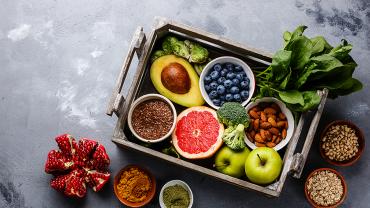
According to researchers from Tufts University’s Human Nutrition Research Center on Aging (HNRCA), NHANES, and the latest U.S. dietary guidelines, regardless of age, weight status, genetics, sex, activity levels, pregnancy, eating patterns, disease status, and use of dietary supplements, “the majority of Americans do not achieve recommended intakes of fruits, vegetables, dairy, and whole grains, foods that provide nutrients that are often under-consumed”. Furthermore, Americans underconsume ten important nutrients according to national dietary intake reports, four of which are of public health concern. In other words, insufficient intake is associated with adverse health outcomes.
Those four nutrients are vitamin D, dietary fiber, and the minerals calcium and potassium. The other six include fat-soluble vitamins A & E, vitamin C, magnesium, iron, and choline.
Moreover, although vegans may consume more dietary fiber from fruits and vegetables and less sodium and saturated fats, they are at a much higher risk for B12, calcium, iodine, and iron deficiencies, therefore may require more frequent testing to check nutrient status. According to a study of nearly 1,500 adults, calcium intake was the lowest for vegans and below national dietary recommendations compared to vegetarians, pescetarians, and omnivores.
There’s no need to explain the various functions that each one of these nutrients perform in the body every day at the cellular level, but rather stressing the importance of educating patients the numerous ways and reasons to boost micronutrient levels as a preventative measure against various conditions and before overt symptoms related to vitamin and mineral deficiencies develop. In accordance with researchers from the HNRCA, “it is important to meet intake goals for these nutrients, since they have been linked to multiple positive health outcomes, are necessary for regulation of many systems in the body, and may help with reduced risk of some diseases.”
To increase intake of these vital, yet underconsumed, nutrients, begin by consuming more vegetables and fruits – not only for the micronutrients, but also for the added dietary fiber. Some great options include adding organic fresh (or frozen) vegetables (especially dark leafy greens) in soups, one-pot meals, and stir-frys, choosing a side of vegetables or salad when eating out at restaurants, and filling grocery carts with items from the outside perimeter of the grocery store (i.e., whole foods vs. processed food-like products). Replace the candy bowl at the office or in the house with whole fruits, and be sure to keep fiber-packed, nutrient-rich snacks handy such as raw nuts and seeds, raw vegetables with hummus or guacamole, or whole fruits with sugar-free nut butter. To optimize iron and choline intake and absorption, omnivores should opt-in for more grass-fed and pasture-raised meats and poultry, whole eggs, and wild-caught seafood, especially shellfish. Legumes, grains, nuts and seeds, and leafy greens such as spinach are great plant-based non-heme iron, but keep in mind in takes exponentially more volume to match the amounts found in animal sources.
For patients who need more aggressive forms of nutrient repletion (i.e., as noted through lab reports or those with malabsorption conditions) supplementation may be their best bet. Suggesting a high-quality multivitamin mineral supplement that includes choline, methylated B-vitamins, magnesium, and iron (especially for females and/or vegans, but always be sure to test iron levels before supplementing) provides a valuable starting point. Additional calcium and vitamin D (plus vitamin K) supplements may also be beneficial for those with frank deficiencies.
And as always, advocating that patients decrease their consumption of refined sugar, sodas, processed foods, table salt, and hydrogenated fats is vital for maintaining optimal nutrient levels, and for helping to deter lifestyle-related diseases, such as metabolic syndrome and cardiovascular disease.
By Caitlin Higgins, MS, CNS, LDN